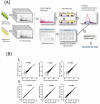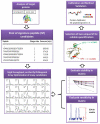Quantitative proteomics in cardiovascular research: global and targeted strategies
- PMID: 24920501
- PMCID: PMC4159306
- DOI: 10.1002/prca.201400014
Quantitative proteomics in cardiovascular research: global and targeted strategies
Abstract
Extensive technical advances in the past decade have substantially expanded quantitative proteomics in cardiovascular research. This has great promise for elucidating the mechanisms of cardiovascular diseases and the discovery of cardiac biomarkers used for diagnosis and treatment evaluation. Global and targeted proteomics are the two major avenues of quantitative proteomics. While global approaches enable unbiased discovery of altered proteins via relative quantification at the proteome level, targeted techniques provide higher sensitivity and accuracy, and are capable of multiplexed absolute quantification in numerous clinical/biological samples. While promising, technical challenges need to be overcome to enable full utilization of these techniques in cardiovascular medicine. Here, we discuss recent advances in quantitative proteomics and summarize applications in cardiovascular research with an emphasis on biomarker discovery and elucidating molecular mechanisms of disease. We propose the integration of global and targeted strategies as a high-throughput pipeline for cardiovascular proteomics. Targeted approaches enable rapid, extensive validation of biomarker candidates discovered by global proteomics. These approaches provide a promising alternative to immunoassays and other low-throughput means currently used for limited validation.
Keywords: Biomarker; Cardiovascular diseases; LC-MS; Mechanism study; Targeted quantification.
© 2014 WILEY-VCH Verlag GmbH & Co. KGaA, Weinheim.
Figures



Similar articles
-
Targeted proteomics strategy applied to biomarker evaluation.Proteomics Clin Appl. 2013 Dec;7(11-12):739-47. doi: 10.1002/prca.201300070. Epub 2013 Oct 31. Proteomics Clin Appl. 2013. PMID: 24123942
-
Translational Metabolomics of Head Injury: Exploring Dysfunctional Cerebral Metabolism with Ex Vivo NMR Spectroscopy-Based Metabolite Quantification.In: Kobeissy FH, editor. Brain Neurotrauma: Molecular, Neuropsychological, and Rehabilitation Aspects. Boca Raton (FL): CRC Press/Taylor & Francis; 2015. Chapter 25. In: Kobeissy FH, editor. Brain Neurotrauma: Molecular, Neuropsychological, and Rehabilitation Aspects. Boca Raton (FL): CRC Press/Taylor & Francis; 2015. Chapter 25. PMID: 26269925 Free Books & Documents. Review.
-
Application of targeted mass spectrometry in bottom-up proteomics for systems biology research.J Proteomics. 2018 Oct 30;189:75-90. doi: 10.1016/j.jprot.2018.02.008. Epub 2018 Feb 13. J Proteomics. 2018. PMID: 29452276 Free PMC article. Review.
-
Advancing translational research and precision medicine with targeted proteomics.J Proteomics. 2018 Oct 30;189:1-10. doi: 10.1016/j.jprot.2018.02.021. Epub 2018 Feb 22. J Proteomics. 2018. PMID: 29476807 Review.
-
Emerging Affinity-Based Proteomic Technologies for Large-Scale Plasma Profiling in Cardiovascular Disease.Circulation. 2017 Apr 25;135(17):1651-1664. doi: 10.1161/CIRCULATIONAHA.116.025446. Circulation. 2017. PMID: 28438806 Free PMC article. Review.
Cited by
-
Estimating the causal effects of genetically predicted plasma proteome on heart failure.Front Cardiovasc Med. 2023 Feb 13;10:978918. doi: 10.3389/fcvm.2023.978918. eCollection 2023. Front Cardiovasc Med. 2023. PMID: 36860279 Free PMC article.
-
Mass spectrometry-based approaches to targeted quantitative proteomics in cardiovascular disease.Clin Proteomics. 2016 Oct 5;13:20. doi: 10.1186/s12014-016-9121-1. eCollection 2016. Clin Proteomics. 2016. PMID: 27713681 Free PMC article. Review.
-
Orthogonal proteomics methods warrant the development of Duchenne muscular dystrophy biomarkers.Clin Proteomics. 2023 Jun 12;20(1):23. doi: 10.1186/s12014-023-09412-1. Clin Proteomics. 2023. PMID: 37308827 Free PMC article.
-
Peptidomic Analysis of Rat Plasma: Proteolysis in Hemorrhagic Shock.Shock. 2016 May;45(5):540-54. doi: 10.1097/SHK.0000000000000532. Shock. 2016. PMID: 26863123 Free PMC article.
-
Cardiovascular biomarkers in body fluids: progress and prospects in optical sensors.Biophys Rev. 2022 Aug 18;14(4):1023-1050. doi: 10.1007/s12551-022-00990-2. eCollection 2022 Aug. Biophys Rev. 2022. PMID: 35996626 Free PMC article. Review.
References
-
- Yusuf S, Reddy S, Ounpuu S, Anand S. Global burden of cardiovascular diseases: Part II: variations in cardiovascular disease by specific ethnic groups and geographic regions and prevention strategies. Circulation. 2001;104:2855–2864. - PubMed
-
- Arab S, Gramolini AO, Ping P, Kislinger T, et al. Cardiovascular proteomics: tools to develop novel biomarkers and potential applications. Journal of the American College of Cardiology. 2006;48:1733–1741. - PubMed
Publication types
MeSH terms
Grants and funding
LinkOut - more resources
Full Text Sources
Other Literature Sources
Miscellaneous

